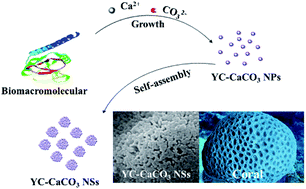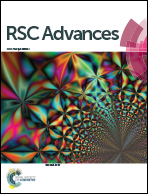Cell-tailored calcium carbonate particles with different crystal forms from nanoparticle to nano/microsphere†
Abstract
Inspired by biomineralization, the first synthesis of size-tunable calcium carbonates from nanoparticles (YC-CaCO3 NPs) to nano/microspheres (YC-CaCO3 N/MSs) with a porous structure was accomplished using a facile method under the mediation of the secretion from yeast cells (YCs). The biomolecules derived from the secretion of YCs were used as conditioning and stabilizing agents to control the biosynthesis of the YC-CaCO3 materials. The morphology and crystal forms of YC-CaCO3 materials can be affected by the biomolecules from the secretion of YCs. With increasing concentrations of biomolecules, the morphologies of the obtained CaCO3 materials changed from nanoparticles to nano/microspheres with a porous structure, while the crystal forms transformed from amorphous to calcite. Functional investigations showed that YC-CaCO3 NSs with a porous structure effectively acted as anticancer drug carriers with accurate and selective drug release in tumor tissue, which suggests that they have great potential to function as a therapeutic delivery system. These application features are mainly attributed to the satisfactory biocompatibility and biodegradability, high drug-loading capacity, and pH-dependent sustained drug release performance of the porous YC-CaCO3 NSs. The biomimetic synthesis strategy of YC-CaCO3 materials mediated by YC secretion not only helps to shed light on the biomineralization mechanism in organisms, but may also lead to a new means of biosynthesizing organic–inorganic nanocomposites.

- This article is part of the themed collection: Editors' Collection: Metals in Medicine


 Please wait while we load your content...
Please wait while we load your content...